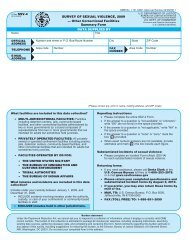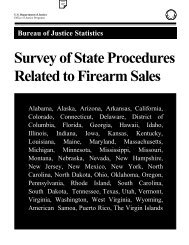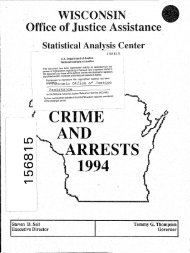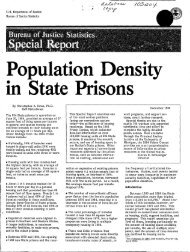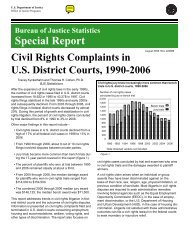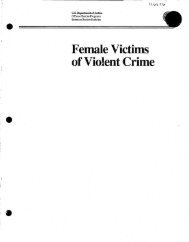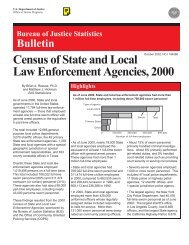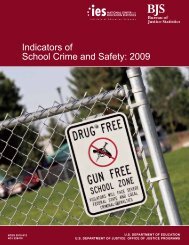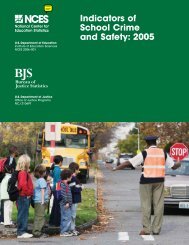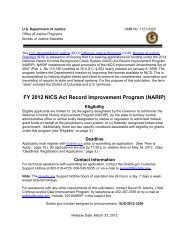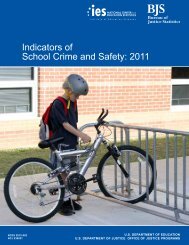Sourcebook of Criminal Justice Statistics, 1983 - Bureau of Justice ...
Sourcebook of Criminal Justice Statistics, 1983 - Bureau of Justice ...
Sourcebook of Criminal Justice Statistics, 1983 - Bureau of Justice ...
Create successful ePaper yourself
Turn your PDF publications into a flip-book with our unique Google optimized e-Paper software.
--------------~-------APPENDIX 8ABC News Crime PollNOTE: Information on the survey procedures used by the ABC News Poll was excerpted from JeffreyAlderman and Peter Begans, ABC News Poll, Survey No. 0066 (New York: ABC News, Feb. 13,<strong>1983</strong>). Non-substantive editorial adaptations have been made.APPENDIX 9The Figgle Report on Fear <strong>of</strong> Crime: America Afrald--Survey methodology and definitions <strong>of</strong> termsNOTE: The following Information has been excerpted from Research and Forecasts, Inc., The FiggieReport on Fear <strong>of</strong> Crime: America Afraid (Willoughby, Ohio: Flggie International, Inc., 1980),pp. 3, 149-160; and from John Crothers Pollock, "Perhaps Evanston Is not America: A Reply toLavrakas et 01.," <strong>Criminal</strong> <strong>Justice</strong> Newsletter, II (22, Nov. 10, 1980), pp. 5-7.MethodologyThe ABC News Poll on crime was based on telephone interviewswith 2,464 men and women, 18 years old and older, and living in thecontinental United States. The survey was conducted during the periodbetween Dec. 7-18, 1982. The sample <strong>of</strong> telephone numbers wereselected by sampling telephone exchanges. Telephone numbers werethen created by adding random digits to the sample <strong>of</strong> telephoneexchanges. Respondents, persons interviewed oj the telephone number,were selected in the following manner: the interviewer first asked tospeak to a male 18 years old or older; if there W/JS mare than one male18 years or older at that telephone number the, interviewer asked tospeak to the youngest male; if no male~ '; 8 years or older wereavailable the interviewer asked to speak to a female 18 years or older;and if more than one female was at that telephone number theinterviewer asked to speak with the youngest.Definitions <strong>of</strong> termsEducatian--Respondents were asked what the last grade <strong>of</strong>school was that they completed. Those who indicated eighth grade orless were included in the grade school group. Those who said they hadsome high school or graduated high school were included in the highschool group. Those who said they had some college, had graduatedcollege, or had post-graduate college were included in the collegegroup.Age--Respondents were asked in what year they were barn.Those barn between 1958 and 1%4 were int:;/uded in the 18 to 24 yeargroup. Those barn between 1953 and 1957 were included in the 25 to29 year group. Those barn between 1933 and 1952 were Included inthe 30 to 49 year group. Those born between 1918 and 1932 wereIncluded in the 50 to 64 year group. Those born before I 91 B wereincluded in the 65 years and older group.Community size--Respondents were asked to characterize thearea they lived in as either a large city, a suburb <strong>of</strong> a large city, asmall town or a rural area.Neighborhood racial characteristics--Respondents were askedto characterize the neighborhood they lived in as either all white,mostly white, about one-half black and one-half white, mostly black, orall black.Neighborhood age structure--Respondents were asked tocharacterize the people living in the neighborhood as either mostly onthe young side (35 years old or younger), mostly middle aged (between35 and 55 years old), mastly older (over 55 years old), or basically amixture <strong>of</strong> all ages.Regions--Survey results are reported for four regional categorieswith States classified in the following way: Northeast--Connecticut,Maine, Massachusetts, New Hampshire, New Jersey, New York,. Pennsylvania, Rhode Island, Vermont; Midwest--IIlinois, Indiana, Iowa,Kansas, Michigan, Minnesota, Missouri, Nebraska, North Dakota, Ohio,South Dakota, Wisconsin; South--Alabama, Arkansas, Delaware, Florida,Georgia, Kentucky, Louisiana, Maryland, Mississippi, North Carolina,Oklahoma, South Carolina, Tennessee, Texas, Virginia, West Virginia;and West--Alaska, Arizona, California, Colorado, Hawaii, Idaho,Montana, Nevada, New Mexico, Oregon, Utah, Washington, Wyoming.Distribution <strong>of</strong> respondentsThe following table shows the number <strong>of</strong> respondents in eachdemographic category. With these data it is possible to determine thefrequency <strong>of</strong> a response in each cell <strong>of</strong> each table extracted from theABC News Crime Poll and the sampling error for each group.NationalSex:MaleFemaleRace, ethnicity:WhiteBlackHispanicOther aMissing casesEducation:CollegeHigh schoolGrade schoolMissing casesEmployment status:Full-time employedPart-time employedUnemployedLaid <strong>of</strong>fRetiredFull-time homemakerStudentMissing casesIncome:1""0020,000",'to ~29,999"~,12,000 to 19,9998,000 to $11 ,999Under $8,000Missing casesAge:18 to 24 years25 to 29 years30 to 49 years50 to 64 years65 years and olderMissing casesCommunity size:Large citySuburbSmall townRuralMissing casesRegion:NortheastMidwestSouthWestNeighborhood racial characteristics:Mostly or all whiteRacially mixedMostly or all blackMissing casesNeighborhood age structure:Mostly younger than 35 yearsMostly between 35 and 55 yearsMostly older than 55 yearsMixed, all agesMissing casesNumber <strong>of</strong>respondentsin survey2,4641,4131,0512,1391861042781,1591,169124121,3373311473635218856176866205302552171563713449524832902447770481045914S506508254391,970363115161855951611,512IIaThis category Is not presented In tab:,es because thenumber <strong>of</strong> respondents In this category is small andheterogeneous.~ i1\I ~\':1 i Iif!Uf,IjIIIPurpose <strong>of</strong> the ReportThe Figgle Report presents the findings <strong>of</strong> a survey conductedby Research and Forecasts, Inc., a subsidiary <strong>of</strong> A-T-O Inc. Thepurpose <strong>of</strong> the report Is to measure the fear <strong>of</strong> crime and examine howIt has affected the lifestyles <strong>of</strong> the American public.Sample selectionThe sample used in this study was a national random-digit sample<strong>of</strong> the telephones <strong>of</strong> the United State constructed for Research andForecasts by Survey Sampling, Westport, Conn.. The method used to construct such samples Involves the use <strong>of</strong> amassive data base that is updated frequently. Using the data base, aspecialized computer program generates a list <strong>of</strong> telephone numbersthat Is organized In such a manner that each telephone has an equalprobablHty <strong>of</strong> being called.The use <strong>of</strong> the random digit dialing technique overcomes one <strong>of</strong>the main objections to telephone surveys, the problem <strong>of</strong> unlistednumbers. Because the data base from which the romple is drawn Isconstructed from working eXchanges supplied by the Nation's telephonecompanies rather than telephone books, both listed and unlistednumbers have an equal probability <strong>of</strong> being called.Another criticism <strong>of</strong> telephone surveys In the post has been thattelephone surveys tend to oversample the affluent, because only theycan afford telephones. However, U.S. Notional Health Service surveysIn 1976 found that 91.6 percent <strong>of</strong> American households now containtelephones. Consequently, although national random telephone surveysmay stili somewhat undersample the poor, It is clear that any bias isrelatively small.Data collectionTwenty trained interviewers conducted phone inte(vlews for aperiod <strong>of</strong> 6 weeks during April and May 1980. The interviews wereconducted during the week between the hours <strong>of</strong> 6 p.m. and II p.m.,and on weekends between the hours <strong>of</strong> 10:30 a.m. and 10:30 p.m. Theinterview took approximately 35 n'lnutes.In order to assure random sek,ction, three call-backs were madefor those telephone numbers that r'~sulted In nan-response before thenumber was discarded. Final non-response was 12 percent <strong>of</strong> the phonecalls and consisted ()f 3 groups: (J J those households where the phonewas not answered; (:!~ !:'o~"" households where Individuals simplyrefused to be Interviewed, and (3) those households for whom the giventime was not convenient. Although three call-backs were made for allthree categories <strong>of</strong> non-response, the first two categories representnon-response problems that will persist regardless <strong>of</strong> Interviewerpersistence. Interviewers attempted to set convenien\' times to callback respondents In the third category to minimize the number <strong>of</strong>individuals In the third category. In addition, 3 percent <strong>of</strong> the phonecalls resulted In Interviews that were terminated while the Interviewwas In progress.One thousand and forty-seven Interviews were fully completedand usable. This represents an 8S percent overall completion rate.Sampling distributionData collection techniques ensured that the randomness <strong>of</strong> thetelephone number selection process was maintained. The randomselection process ensures access to probability theory to measure thescmpllng error for the sample.A table <strong>of</strong> the estimated sampling error for binomIal percents atthe 95 percent confidence level Is presented below.Recomended allowonce for sampling error (plus or minus) at 95percent confidence level(Percent)PercentagesSam21e sizenear 1,000 900 800 700 600 500 400 300 200 10010 or 90 2 2 2 2 2 3 3 4 4 620 or 80 2 3 3 3 3 4 4 5 6 830 or 70 3 3 3 4 4 4 5 5 6 940 or 60 3 3 4 4 4 4 5 6 7 1050 3 3 4 4 4 4 5 6 7 10The geographic distribution <strong>of</strong> the respondents is as follows:East, 23 percent; Midwest, 25 percent; West, 21 percent; and South, 31percent.WeIghtingThe inItial sample did not exactly correspond to recent U.S.<strong>Bureau</strong> <strong>of</strong> the Census estimates <strong>of</strong> the demagraphic char'acteristlcs <strong>of</strong>the population over age 18. In order to make the two popUlationscorrespond mare closely, the sampled popUlation was weighted on twovariables: gender and Income.The Census <strong>Bureau</strong> estimates the 1979 popUlation over III asbeing 41.9 percent male cnd 58.1 percent female. In order to correctthe sample fIndings to approximate the census figures, males in thesample were Increased by a factor <strong>of</strong> 1.136 and females were decreasedby a factor <strong>of</strong> .902.SimIlarly, the Income groups were weighted. The group earningunder $2,999 for 1978 (5.9 percent <strong>of</strong> the sample) was multiplied by afactor <strong>of</strong> 3.4. Those earning $3,000 to $7,999 per year (15.7 percent <strong>of</strong>the sample) were multiplied by a factor <strong>of</strong> 1.2. Those earning $8,000to $11,000 (11.5 percent <strong>of</strong> the sample) were mUltiplied by a factor <strong>of</strong>I. Those earning $11,000 to $15,999 per year (14.5 percent <strong>of</strong> thesample) were multiplied by a factor <strong>of</strong> .61. Those earning $16,000 to$21,000 (16.9 percei,t <strong>of</strong> the sample) were multiplied by 0 factor <strong>of</strong> .65.Those earning $21,000 or over (35.5 percent <strong>of</strong> the sample) weremultllllled by a factor <strong>of</strong> I.Construction <strong>of</strong> composite measuresThe "formless fear index" is a Guttman scale constructed fromresponses to six questions concerning s<strong>of</strong>ety felt at home, in theneighborhood, or In the central business distrIct, during the day, andduring the night. For each item, response categorie~ were "frequently,""sometimes," "rarely," or "never." The "concrete fear index" is aGuttman scale built from six questions asking respondents how <strong>of</strong>tenthey worried about being a victim <strong>of</strong> murder, sexual assault, mugr1ng,knifing, beating, or armed robbery. For '1hese items, responsecategories were "very safe," "somewhat safe," "somewhat unsafe," or"very unsafe." In each scale, the individual items were dichotomizedinto values <strong>of</strong> 0 and I and sunmed to arrive at a score ranging from 0to 6. For the concrete fear scale, responses <strong>of</strong> "frequently" and"sometimes" were giVen scores <strong>of</strong> I. "Rarely" and "never" responseswere given scores <strong>of</strong> O. For the formless fear scale, responses <strong>of</strong> "verysafp," and "somewhat safe" were given scores <strong>of</strong> O. "Somewhat unsafe"and "very unsafe" responses were given scores <strong>of</strong> O. In both scales,total scores <strong>of</strong> 0 to 2 were classified as moderate to low levels <strong>of</strong> fearand scores <strong>of</strong> 3 to 6 as high fear level.The "confidence in the local police index" combines severalqUestionnaire items In order to create an overall measure <strong>of</strong> attitudestoward local police. The Items included In the Index were as follows:--"In general, would you rate your local police deportmentas: excellent or good (I), fair or poor (D)?"--"The local police treat people <strong>of</strong> all races the same."(agree= I, dlsagree=O)--"The local police Just enjoy push:ng people around andgiven them a hard time." (agree= I, disagree=O)--"The local police spend most <strong>of</strong> their time going afterpeople who do little things wrong and ignore mast <strong>of</strong> the badthings goIng on." (agree=O, dlsagree= I)--"Which <strong>of</strong> the following best describes your local police<strong>of</strong>ficers?" (respectful= I, arrogant=O)--"Do police use too much force?" (yes=O, no= I)As with the other composite scores, the police confidence index wasthe sum <strong>of</strong> the responses to each Index item. However, unlike theother Indices, the "confidence in the local police index" did not form aGuttman scale. ''High'' confidence in the local police was assigned tosums <strong>of</strong> 3 to 6 and "low" confidence to totals <strong>of</strong> less than 3.Community size Is the respondents' subjective classIficatIon <strong>of</strong>their residential environment. This is distinct from many otherdefinitions <strong>of</strong> comnunlty size that rely on population counts and U.S.<strong>Bureau</strong> <strong>of</strong> the Census definitions.652653



